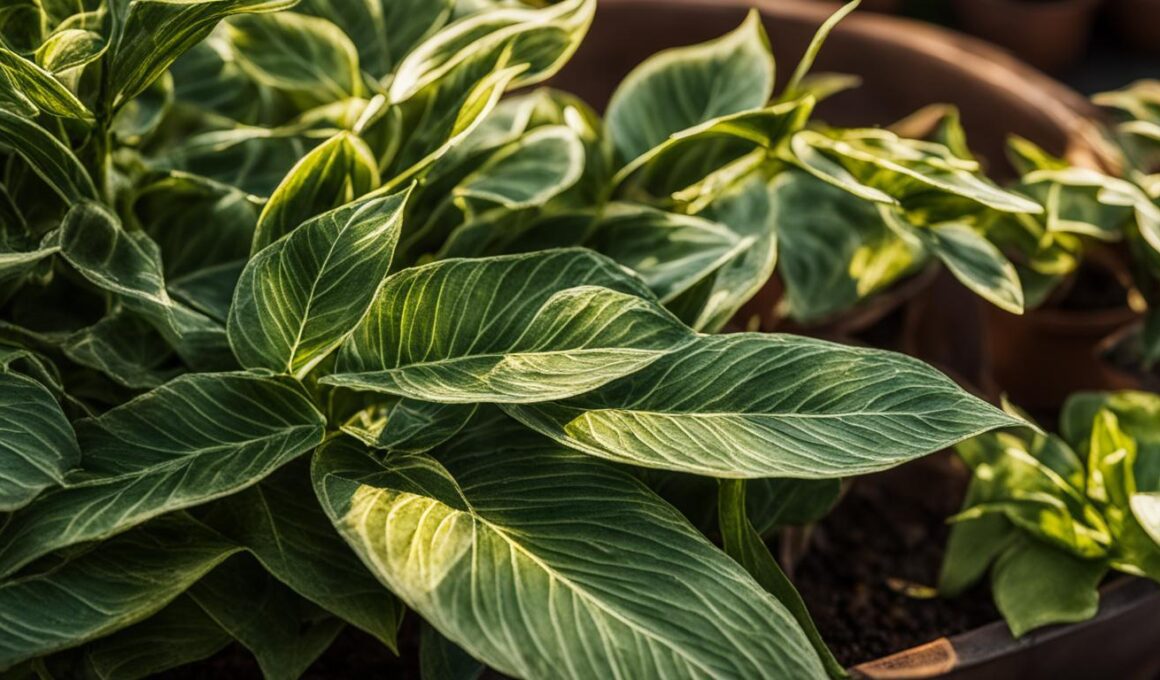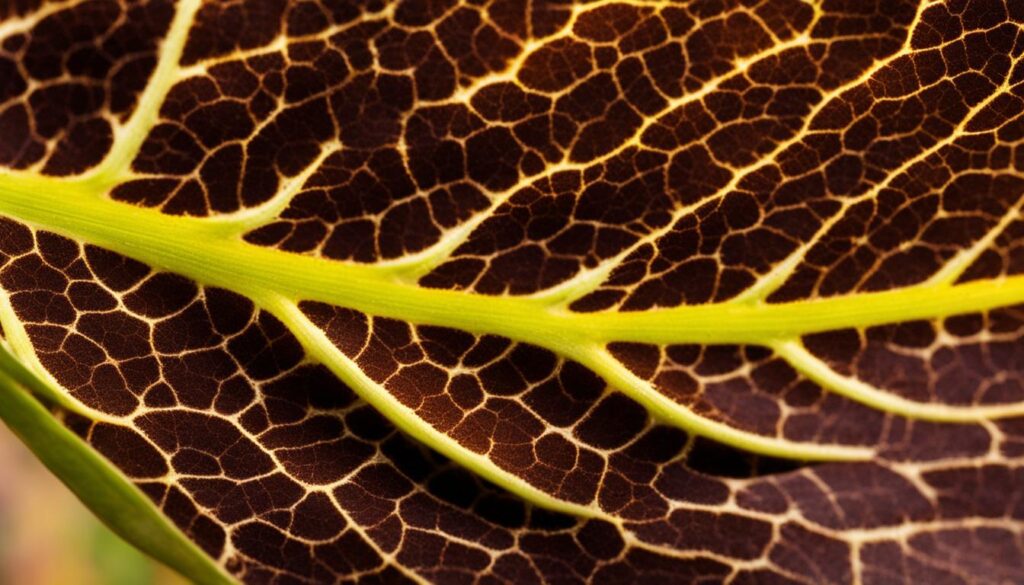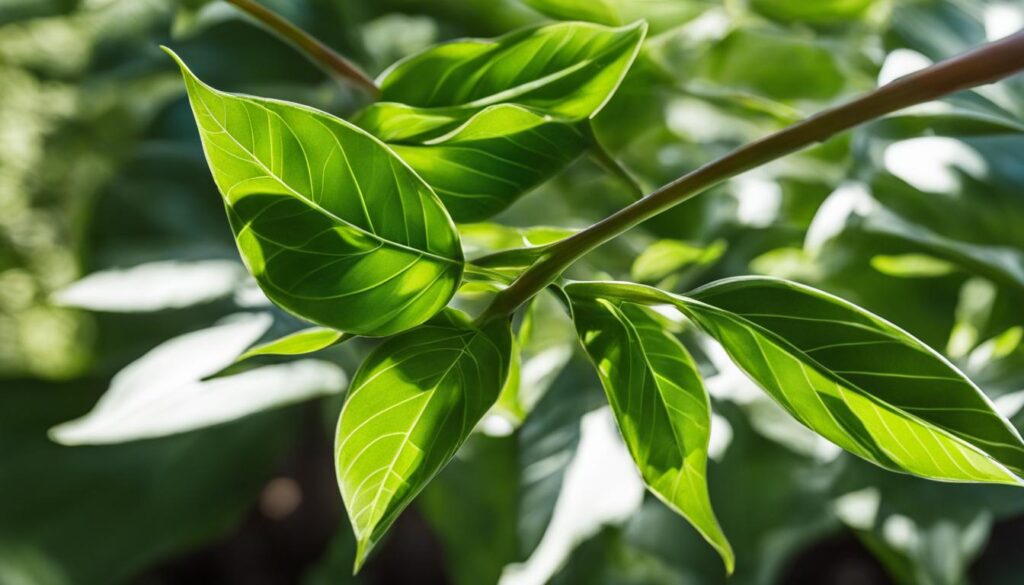Leaf sunburn is a common problem that can have detrimental effects on your plants. It occurs when plants are exposed to excessive sunlight, leading to discoloration of leaves and potential damage to bark and fruit. However, there are steps you can take to prevent leaf sunburn in the first place, such as providing proper care, monitoring watering practices, and choosing native plants adapted to your climate. If your plants do experience sunburn, there are also effective cures to help them recover and thrive.
Key Takeaways:
- Leaf sunburn can damage the health of your plants, but prevention is possible.
- Proper care, watering practices, and selecting native plants can help prevent leaf sunburn.
- Gradually transitioning plants to new locations with different levels of sunlight can reduce the risk of sunburn.
- If your plants experience sunburn, remove damaged leaves, provide shade, and water generously to aid in recovery.
- By prioritizing plant care and proactive measures, you can protect your plants from leaf sunburn and ensure their vitality.
Understanding Sunburn and Sunscald in Plants
Sunburn and sunscald are two common forms of plant damage caused by excessive sunlight. Sunburn occurs when plants are exposed to intense sunlight for prolonged periods, leading to leaf discoloration and potentially damaging the foliage. It typically starts as pale green or white patches on the leaves, which then progress to yellow and brown as the damage worsens. This discoloration can often be mistaken for nutrient deficiencies or diseases, but it is important to recognize sunburn as the primary cause.
On the other hand, sunscald primarily affects the bark and fruit of plants. It occurs when direct sunlight overheats the outer layer of the trunk, causing it to crack and creating an entry point for pests and diseases. Sunscald can have devastating effects on the health and productivity of plants, making it crucial to identify and address this issue promptly.
The sequel follows a combination of factors that contribute to both sunburn and sunscald, including excessive sun exposure and lack of soil moisture. These conditions result in stress for the plants, making them more susceptible to damage. Being aware of these causes and taking appropriate measures to prevent sunburn and sunscald can help protect the overall well-being of your plants and ensure their longevity.
Effects of Sunburn and Sunscald:
- Leaf discoloration, ranging from pale green to yellow and brown
- Cracking of the bark and fruit, leading to potential infections
- Reduced photosynthesis and overall plant vigor
- Decreased fruit quality and yield
Preventing Sunburn and Sunscald:
- Provide shade to plants during peak sunlight hours
- Water plants consistently, ensuring they have enough moisture to withstand heat stress
- Choose plant varieties that are well-adapted to your climate and sunlight intensity
- Apply a layer of mulch around the base of plants to retain soil moisture and regulate temperature
By understanding the causes and effects of sunburn and sunscald, as well as implementing preventive measures, you can safeguard your plants against these damaging conditions. Taking the time to protect your plants from excessive sunlight will contribute to their overall health and longevity, allowing them to thrive in their environment.
Preventing Leaf Sunburn in Plants
When it comes to protecting your plants from leaf sunburn, prevention is key. By implementing proper watering practices, selecting native plants, and employing horticultural techniques, you can significantly reduce the risk of sunburn and ensure the health of your plants.
Watering Practices
One of the most important factors in preventing leaf sunburn is maintaining proper watering practices. To ensure your plants receive adequate moisture, water them according to their specific needs. Avoid midday watering for plants with hairy leaves, as this can increase the likelihood of sunburn. Instead, water in the early morning or late afternoon to give plants a chance to absorb and utilize the water effectively.
Native Plants
Choosing native plants adapted to your USDA plant hardiness zone is another effective way to prevent leaf sunburn. Native plants are naturally acclimated to the local climate and are better equipped to withstand the intense sunlight in your area. Research and select plants that are known to thrive in your region, as they will have a higher tolerance for sun exposure and are less likely to experience sunburn.
Horticultural Practices
In addition to proper watering and selecting native plants, practicing appropriate horticultural techniques can further reduce the risk of leaf sunburn. This includes providing sufficient shade for delicate plants during particularly hot days, using mulch to insulate the soil and retain moisture, and maintaining proper soil fertility to support healthy plant growth. These horticultural practices create a favorable environment for your plants and help them better withstand intense sunlight.
By following these preventive measures, you can minimize the chances of leaf sunburn and ensure the long-term health of your plants. Remember to be attentive to your plants’ needs and provide them with the care and attention they require to thrive in the face of sunburn challenges.
Gradual Transition for Healthy Plant Growth
When it comes to moving plants to new locations with different levels of sunlight, it’s crucial to ensure a gradual transition. Sudden exposure to intense sunlight can lead to sunburn and cause damage to your plants. To avoid this, start by moving your plants to a slightly sunnier spot for short periods of time, gradually increasing the amount of sunlight they receive over a period of weeks.
This acclimation process allows your plants to adjust to their new environment and reduces the risk of sunburn. Remember, it’s always better to err on the side of less sunlight initially to protect your plants and ensure their healthy growth. Give them the time they need to adapt and thrive in their new surroundings.
Why Is Gradual Transition Important?
Gradual transition is important because plants can become accustomed to their existing environment. Sudden changes in sunlight exposure can cause stress and damage to their leaves, hindering their growth and overall health.
By gradually increasing the amount of sunlight your plants receive, you allow them to develop stronger leaves that are better equipped to handle higher levels of sunlight. This helps prevent leaf sunburn and promotes healthy plant growth.
So remember, when moving your plants to a new location, make sure to provide a gradual transition to allow them to acclimate to their new surroundings. By taking this simple step, you can protect your plants from sunburn and ensure their healthy growth and vitality.
Recovering and Caring for Sunburned Plants
If your plants have experienced sunburn, it’s essential to take immediate action to help them recover. Here are some steps you can take to care for your sunburned plants:
1. Remove Damaged Leaves
Start by carefully inspecting your plants for any leaves that have been extensively sunburned. These leaves will appear withered, discolored, or dried out. Gently remove the damaged leaves, trimming them at the base where they connect to the stem. Removing these leaves will allow your plants to channel their energy into new growth.
2. Provide Shade with a Shade Cloth
Protect your sunburned plants from further damage by providing shade using a shade cloth. This breathable fabric can be strategically placed over your plants to shield them from intense sunlight. The shade cloth should be positioned above the plants, allowing air to circulate and preventing heat buildup. This will create a more favorable environment for your plants to recover.
3. Generously Water Your Plants
One of the most crucial steps in caring for sunburned plants is maintaining proper hydration. Water your plants generously, ensuring that the soil is thoroughly moistened. This will help alleviate the stress caused by sunburn and promote healthy growth. Monitor the moisture levels regularly and adjust your watering frequency as needed to keep the soil consistently moist.
Remember, patience is key when nursing sunburned plants back to health. Monitor their progress closely and continue providing them with the care they need. With time and proper care, your plants will have the opportunity to recover and thrive once again.
Note: The image above illustrates sunburned plants, highlighting the importance of taking appropriate steps for their recovery.
Conclusion
In conclusion, taking proper care of your plants and implementing preventative measures is crucial for preventing leaf sunburn. By understanding the causes of sunburn and implementing strategies such as proper watering practices, choosing native plants, and gradual transitions, you can effectively protect your plants from sunburn damage.
If sunburn does occur, it’s important to take immediate action to aid in the recovery process. Removing damaged leaves promotes new growth, while providing shade with a shade cloth reduces further damage. Additionally, generous watering helps hydrate the plant and alleviate stress caused by sunburn.
Remember that plant care should always be a priority. By prioritizing plant care and taking proactive steps, you can ensure vibrant and healthy plants in the face of sunburn challenges. By following these guidelines, you can minimize the risk of sunburn, promote plant health, and enjoy beautiful and thriving plants in your garden.
Can Hydrogen Peroxide Help Prevent or Cure Leaf Sunburn on Plants?
Yes, using hydrogen peroxide on plants can help prevent and cure leaf sunburn. By diluting hydrogen peroxide and spraying it on affected leaves, you can help the plant recover and prevent further damage. Its antifungal and antibacterial properties can also protect against infections caused by sunburn.
FAQ
What is leaf sunburn?
Leaf sunburn is a common problem in plants that occurs when they are exposed to excessive sunlight, resulting in discoloration of leaves and potential damage to bark and fruit.
What is the difference between sunburn and sunscald?
Sunburn primarily affects the foliage, causing pale green or white discoloration on leaves that progresses to yellow and brown. Sunscald, on the other hand, primarily affects the bark and fruit, causing cracks and making the plant susceptible to pests and diseases.
How can I prevent leaf sunburn?
You can prevent leaf sunburn by practicing proper watering techniques, choosing native plants adapted to your climate, and employing horticultural techniques. Providing adequate moisture, avoiding midday watering for hairy-leaved plants, and gradually transitioning plants to new locations with different sunlight levels can also help prevent sunburn.
How should I transition my plants to new locations?
It’s important to transition plants to new locations gradually. Start by moving them to a slightly sunnier spot for short periods, gradually increasing the amount of sunlight they receive over weeks. This acclimation process allows plants to adjust to their new environment and reduces the risk of sunburn.
What can I do if my plants get sunburned?
If your plants experience sunburn, you can help them recover by removing damaged leaves, providing shade with a shade cloth, and generously watering them to alleviate stress. Monitoring their progress and providing ongoing care will support the healing process.












